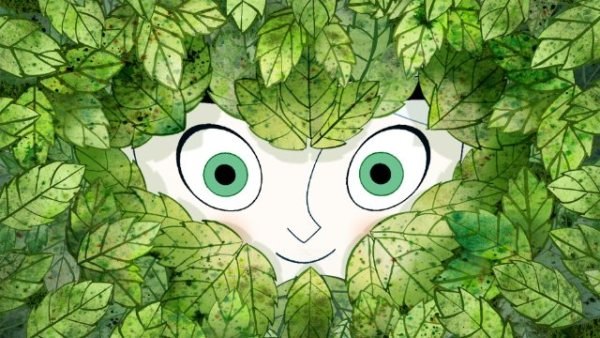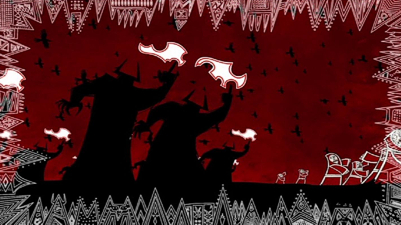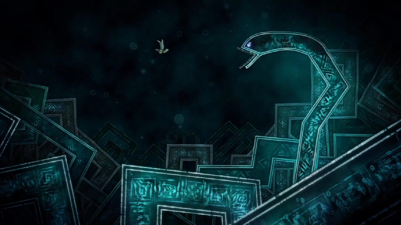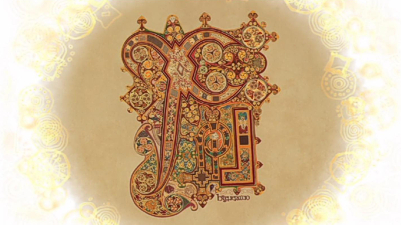The Secret of Kells draws on historical facts to serve as the backbone of its story. The abbey of Kells, where the events take place, was a real monastery in Ireland. Though in the movie the Vikings, or "Northmen," are portrayed demonic figures, more monster than men, Viking invasions did happen, beginning in the late 700s, and monasteries were a favorite target. In the movie, the abbey of Kells takes in Brother Aiden and other refugees fleeing from the Northmen, which the real abbey also historically did. Brother Aiden escapes with from a monastery in Iona, where Vikings were pillaging, to finish it in the Kells, which is the most prevalent theory among scholars on how the Book of Kells was made. The scenery in The Secret of Kells was based on history; the beehive huts used by the monks and the abbey of Kells mirror the real buildings found in Ireland. Brother Aiden's cat, Pangur Bán, is also a historical reference; in the 800s, a Irish monk in Reichenau Abbey wrote a little poem about his cat, Pangur Bán, in the margins of a manuscript. Since the creation of the Book of Kells is shrouded in mystery, the creators of the movie had to add their own flair to history; the specific story the movie relates never happened. However, they did use historical facts to provide a basis for their narrative.
While The Secret of Kells incorporates historical elements to set up the story, it also uses fantasy to build on the narrative and demonstrate the mixing of Catholicism and Celtic Mythology. In the enchanted forest, Brendan befriends a fairy, Aisling, and battles the Dark One, Crom Cruach. In Irish writing, an aisling is a poem about a dream where Spring personified helps the dreamer. Crom Cruach was a pagan deity worshipped before Christianity came to Ireland, and blood sacrifice was probably included in rituals dedicated to him. Paganism and Catholicism live side-by-side in Brendan's world, which reflects the religion and culture of Ireland in the 800s. Catholic monks would try to assimilate pagan beliefs with their own, which Pope Gregory I advised. Pagan festivals would become church holy days and temples created for pagan deities would be used to conduct Mass. The movie is not animated realistically; instead, it is flat and intricate, which mimics the illuminations in the Book of Kells. The Book in the movie is given almost divine status; whoever sees it has an awestruck expression, the monks protect it at all costs, and the pages shine with light. This treatment of the book could represent the importance of knowledge, faith, and the unique Irish culture. While the fantastical elements in the movie may not be realistic, they do illuminate what life may have been like in the 800s.
The Secret of Kells utilizes both history and fantasy to relate Brendan's journey to finish the Book of Kells. While not always historically accurate, it provides a look into what it must have felt like to live in the 800s in Ireland, where Catholicism and Paganism blended together, Vikings attacks were a feared danger, and an exquisitely illuminated book could create a lasting cultural impact.
Sources:
Bennet, Judith M. Medieval Europe: A Short History. 11th ed. New York: McGraw-Hill, 2011. Print.
Orizaga, Rhiannon Y. "The Secret of the Kells." Latest Films. Mnemonic Productions, n.d. Web. 11 Sept. 2016. <http://www.filmstory.org/films/27>.
"The Book of Kells." Book of Kells. Library of Trinity College Dublin, 10 June 2016. Web. 11 Sept. 2016. <https://www.tcd.ie/Library/manuscripts/book-of-kells.php>.










Erin, This was a great blog. I really enjoyed reading it and now I am going to have to watch the movie. I really liked your analysis on the foundation for the film relying on historical facts but the story-line requiring imagination by the writers. I think that the foundation of historical facts for a narrative, as you argue as well, is what we must take away. Although the stories may be imagined, the viewers are still being exposed to the events that happened in history. Overall, thank you for such an interesting and thorough blog. I really enjoyed your blog.
ReplyDeleteNice sense of connection to history. Definitely a strong film, and the use of celtic knotwork in the animation (illumination) is also great.
ReplyDeleteAfter learning about the Book of Kells in class and having mentioned this movie, I had to check it out myself on Netflix - I really enjoyed it! I noticed that the Northmen wore the horned helmets, despite it being a historically Celtic feature. It's interesting after watching the film to see how it truly ties in to history (I'm excited that little Pangur Ban was real!). It's interesting how they tied in Aisling and Crom Cruach - they're themes whose depth might be lost without actually considering the history. You really connect it all well and make the story even better - great blog!
ReplyDeleteThis blog is great and the animation looks and sounds super cute, I'm going to have to go check it out. I love how detailed this analysis is, good job.
ReplyDeleteI really enjoy how detailed your blog is. Also, I like how you included a modern film. Movies are a unique way to spark curiosity within people and make them want to learn more about a topic. Lastly, I like how you discussed the accurate and non-accurate depictions of this time period and the Vikings that are presented within this movie.
ReplyDelete